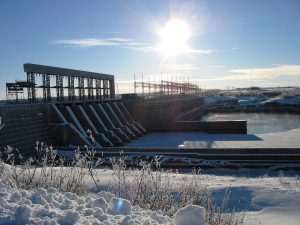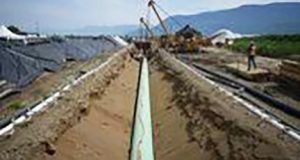The Romaine-4 hydroelectric project may be last major dam project on the horizon as modernized environmental assessments prevent trampling of Indigenous rights.
By Morgan Lowrie
THE CANADIAN PRESS
MONTREAL- Quebec’s hydro dams have long provided its residents cheap electricity and bragging rights in the race to reduce global carbon emissions, with Premier Francois Legault suggesting the province could become the “green battery of North America.”
But as the premier signs lucrative export deals with states such as Massachusetts and New York, the province’s utility has acknowledged that the Romaine-4 hydroelectric project, scheduled to enter service next year, could be the last major dam project for the foreseeable future.
Francis Labbe, a spokesman for Hydro-Quebec, confirmed that the utility doesn’t have other hydro projects on the horizon. He said such projects take at least a decade to plan and build, adding that they don’t come cheap, as Romaine’s $7.3-billion price tag attests.
In the meantime, prices for other kinds of renewable energy, such as wind power, have fallen, making them more attractive options.
“It may come to a point where we come to the conclusion that we need another hydroelectric project but right now, considering the delays, considering the cost, considering that we have other options, we will not go in this direction,” Labbe said in a recent interview.
Quebec started building the four-part Romaine project, described at the time as the biggest construction project in Canada, in 2009.
The commissioning of Romaine-4, the last of the dams, was pushed back to 2022 from 2020 after a series of delays, including the pandemic and other health and safety concerns.
Labbe said the dam and reservoir are complete and work is underway on the power station. When it is commissioned next fall, it should supply about eight terawatt hours, enough to power about 450,000 homes.
While Labbe says the utility has enough power in reserve to serve the province and its export contracts until 2025 or 2026, it will be putting out a call for tenders for projects to provide 300 megawatts of wind power and 480 megawatts of renewables, which could include wind and solar.
That’s in addition to the Apuiat wind energy project developed with the Innu of the Cote-Nord region, which should provide some 200 megawatts when it’s commissioned in 2024.
Francois Bouffard, an associate professor of electrical engineering at McGill University, says the megaprojects that propelled the company to early success are “a development model of the past.”
“Nothing is really carbon-free,” he said.
In the absence of future hydropower projects, the company has been moving into other domains. In addition to wind partnerships, Hydro-Quebec recently inaugurated its first two solar energy plants.
It has also formed a subsidiary designed to help customers improve their energy efficiency, and it is working on large-scale batteries that can store surplus energy.
Experts say that far from becoming redundant, Quebec’s massive hydro dams will become more important than ever as the province shifts to alternate sources of power.
Louis Beaumier, the executive director of the Trottier Energy Institute at Polytechnique Montreal, agrees that building more “titanic” dam projects doesn’t make sense, largely due to the cost.
But he says the main advantage of hydro power is that, unlike wind or solar, it provides a consistent stream of power that can be increased or decreased fairly easily to meet fluctuating demand. The power stored in the province’s reservoirs amounts to “the biggest battery you can every build,” he said, and one that puts Quebec in a uniquely advantageous position of being able to move forward with new technologies while always having hydro as a backup.
Bouffard and Beaumier agree that the Crown corporation will have to adjust to yet more changes in the coming years. With the Quebec government as its only shareholder, Hydro-Quebec’s mandate is to bring in revenue for the province, meet provincial electricity needs and keep rates low, all at once.
Increasingly, the province has looked to expand sales to the United States in order to grow. Legault has made no secret of his desire to see the province expand exports to the northeastern United States, even as the province was dealt a blow when Maine voters rejected a plan to run transmission lines through their state on their way to Massachusetts. (Legault has said he remains confident the project will go ahead).
Bouffard believes the future of the company may lie outside North America altogether, as it looks to sell its valuable expertise to developing countries. Beaumier, for his part, says the company should also play a role domestically as the federal government moves toward its goal of reaching net-zero emissions by 2050. He said Hydro-Quebec could be doing more in helping to meet those goals.
Hydro-Quebec’s Labbe underplayed the extent of the culture shift that is underway at the utility. He notes that while Romaine is the last major project planned, the company still has plenty of work to do managing and maintaining its 62 existing power stations. Plans are already underway to make several of them more efficient.
“This is far from the end of hydroelectricity in Quebec,” Labbe said.
This report by The Canadian Press was first published Dec. 21, 2021.
 Aboriginal Business Magazine Your source for Aboriginal Business News
Aboriginal Business Magazine Your source for Aboriginal Business News




